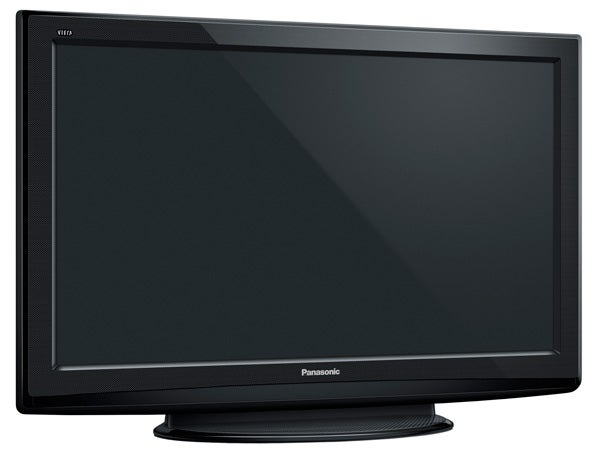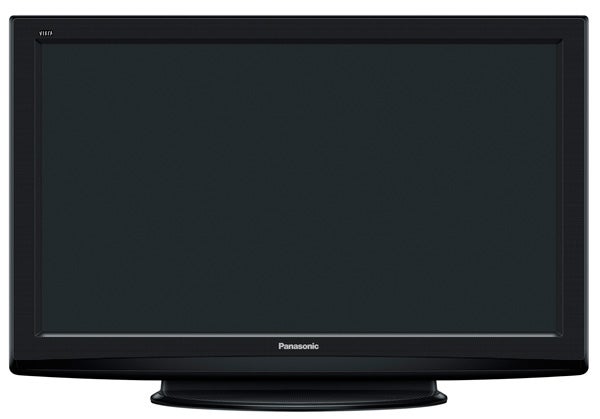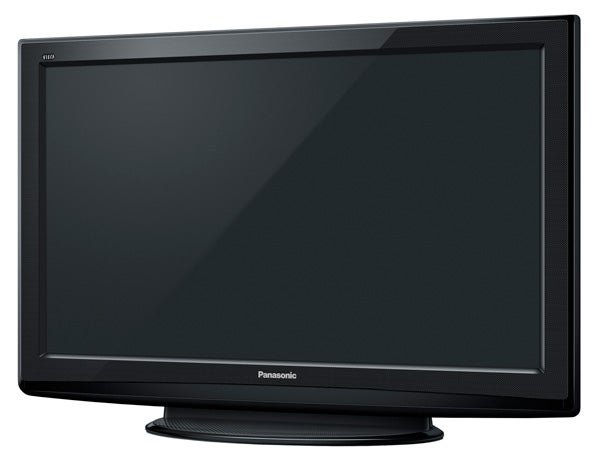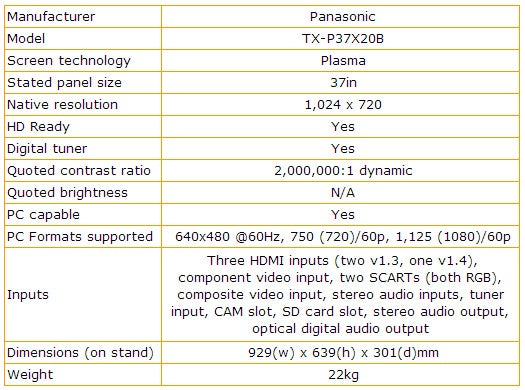Panasonic Viera TX-P37X20B 37in Plasma TV Review
Panasonic Viera TX-P37X20B 37in Plasma TV
The TX-P37X20B is a tempting option for a reasonably serious, HD-loving, but cash-strapped AV fan.

Verdict
Key Specifications
- Review Price: £550.00
With LCD TVs making such large leaps forward over the past 12 months, the arrival of the first screen from Panasonic’s 2010 plasma TV range is a source of as much trepidation as celebration. Especially as some of last year’s Panasonic plasmas left me feeling just a little cold, if I’m honest. Will the 37in TX-P37X20B show that plasma is keeping up with the LCD/LED joneses, or will it look like yesterday’s news?
The first thing to say about the P37X20B is that it’s impressively cheap for a 37in plasma TV; £550 would look fair even a few months after launch, but the TV is going for that already, despite only being available for a few days.
The next thing that catches my eye is the set’s design – though not necessarily for the right reasons. For while its finish looks marginally more opulent than that of last year’s Panny plasmas, thanks to a touch more gloss, the sculpting remains fundamentally unimaginative, and the lack of any metal trim or subtle colours to alleviate the full-on blackness is a shame.
The P37X20B sits right at the bottom of Panasonic’s new plasma range. And this lowly positioning is evident to some extent in its connections. For instance, you only get three HDMIs when many screens now are doing four. Though interestingly, one of these HDMIs is a 1.4 rather than the usual 1.3 grade, meaning it carries Audio Return Channel support. 
There’s no Ethernet port for DLNA functionality or connecting to Panasonic’s VieraCast online service, though, nor is there a USB port for playing files from a USB stick. Even more startlingly there’s no D-Sub PC input, meaning you’ll have to use one of the three HDMIs for computer connection. Naturally this makes the provision of just three HDMIs potentially all the more troublesome.
The set isn’t a complete multimedia washout though, for it does cling to an SD card slot through which you can play JPEG still photos or AVCHD video files. This slot can take SDXC cards, too. To be honest, though, if I’d been Panasonic and I’d had to choose between a USB and an SD card slot on my new entry-level TV, I would personally have gone the USB route, due to the fact that USB storage sticks are so much more portable and practical for shifting between devices than tiny SD cards.
As you’d expect with a 37in plasma TV, the P37X20B doesn’t manage to fit in to its relatively small frame a Full HD resolution of plasma cells; instead it goes for Panasonic’s unusual 1,024 x 720 pixel count – a set up that delivers a widescreen aspect ratio because Panasonic uses a horizontally elongated plasma cell structure designed to improve colour balance.
Some of you will doubtless be immediately put off the P37X20B because it doesn’t have a Full HD picture. But if that’s you, just bear in mind that many times I’ve found video processing and a TV’s core engine to be far more important to image sharpness than mere resolution.
The TV’s native contrast, meanwhile, is rated at 2,000,000:1, a figure that looks stupendously good against the black level claims of rival LCD TVs – though only about average by today’s high and mighty plasma standards.
Other features of note include 100Hz processing which doubles the PAL refresh rate for enhanced motion, colours and image stability, and the introduction of Panasonic’s latest VReal 5 picture processing engine.
However, crucially the P37X20B does not use one of Panasonic’s NeoPDP panel designs. This means it won’t benefit from the high brightness/low running power advantages of NeoPDP, or the new filter/discharge gas/phosphor/redesigned plasma cell structure improvements made for 2010’s upcoming NeoPDP range (which kicks in at the G20 range).
Heading into the P37X20B’s menus reveals one or two new menu items. There’s a Vivid Colour option, for a start, which basically does exactly what it says on the tin. Plus there’s an option mysteriously called C.A.T.S., which turns out to stand for Contrast Automatic Tracking System. Despite the fancy name, though, this is actually nothing more startling than one of those now-common tools where the TV automatically adjusts picture settings in response to the amount of ambient light in your room.
One final feature point to raise before getting into the P37X20B’s performance is that it doesn’t have Freesat or Freeview HD tuners – those only kick in at Panasonic’s new G20 plasma screen level. You just get standard def Freeview and analogue reception.
In action, the P37X20B is a solid enough effort, but not the heart-stopping budget maestro I’d been hoping for.
On the plus side, as I would expect, the P37X20B has excellent black levels by affordable flat TV standards. Dark scenes manage to get nearly as black as the TV’s inky bezel, with no grey clouding worth mentioning. What’s more, the darkness is superbly uniform, with none of the backlight inconsistencies I often see to some extent with LCD screens.
Also giving the P37X20B a big leg up over most budget 37in TVs is the effortlessness of its black level reproduction. By which I mean that since the plasma screen doesn’t have to dim the whole picture to produce a respectable black colour, dark scenes are able to retain plenty of shadow detail and avoid that crushed look so common with LCD rivals.
There’s still one further contrast benefit with the P37X20B too, namely that unlike the vast majority of LCD TVs, its pictures don’t lose contrast – or colour saturation – when watched from wide viewing angles. This makes the P37X20B a potentially perfect option for people with large families and small living rooms, where some poor soul inevitably ends up having to watch TV from a nasty angle.
Another considerable, plasma-generated P37X20B picture asset is its freedom from motion blur relative to LCD TVs. Panasonic is only too happy to boast on the box about the P37X20B’s 0.001ms response time (versus a bare minimum of 4ms on budget LCD TVs), and there really isn’t any sign at all of the blurring and resolution loss when showing moving objects that we’ve become accustomed to seeing with affordable LCD TVs.
HD pictures, meanwhile, look enjoyably detailed and crisp despite the screen not having a full HD resolution, proving the point I raised earlier that sometimes the quality of a screen’s processing and core electronics is more important to sharpness than hard resolution.
HD pictures also enjoy some generally very good colour toning that combines a surprisingly deft touch when portraying blends with some really believable hues. It’s especially good with HD skin tones versus cheap LCD TVs – particularly since the rather orangey undertone noted on some of last year’s cheap Panasonic’ plasmas has been reduced (though not totally removed).
Let’s make no bones about it: with a good HD source, the P37X20B’s pictures are capable of looking really very good indeed.
There are a number of reasons, though, why the P37X20B is only a good rather than a great entry level TV. Kicking off with the fact that despite carrying 100Hz processing, the P37X20B’s pictures are a little prone to judder.
The P37X20 isn’t a particularly talented standard definition performer, either. For oddly (given that the HD Ready screen isn’t having to work as hard to upscale standard definition as a full HD screen would), its standard definition pictures look softer and less detailed than I’d like.
Standard definition pictures are also much more prone to rogue colour tones than HD ones, with the extent of the colour tone irregularities depending directly on how low in quality the source material is. For instance, while footage shot in the carefully controlled environment of the Sky News studio looks quite natural, whenever the footage switches to an outside broadcast, you can immediately see flesh tones becoming inconsistent (either too pink or too orange), greens becoming muted, and the overall colour palette looking less dynamic.
The example I’ve given there is a little extreme, I guess, since it’s not often that normal TV fare plumbs the quality depths of your typical outside news broadcast. But the P37X20B also displays more picture quality difference than usual when switching between low and high quality digital TV channels.
Another issue is that the P37X20B’s post-calibration picture isn’t as bright as your typical LCD screen (though you do, of course, get the P37X20B’s contrast benefits as ample compensation). And finally, I was disappointed by how reflective the toughened glass screen is of lights and objects in your room. This could become a quite major problem in very bright environments.
The P37X20B’s audio, meanwhile, is pretty much par for the affordable 37in TV course. Which means that a lack of bass and treble extension leaves the mid-range sounding rather crowded. However, the P37X20B does at least have enough raw power handling not to let that crowding tip over into distortion. Plus it’s able to nudge up at least half a gear when required by a potent action scene, avoiding that boring one-dimensionality so commonly heard with relatively small and affordable flat TVs.
”’Verdict”’
The P37X20B is a tempting option for a reasonably serious, HD-loving, but cash-strapped AV fan. It delivers some clear and desirable advantages over similarly priced LCD screens and achieves an incremental improvement over last year’s X10 series.
However, it’s not without weakness, and I have to say from what I’ve seen at various demos so far that it’s actually Panasonic’s new G20 and higher plasma series that look more likely to set 2010 alight. So if you can manage to save up for one of those (though admittedly the P42G20 is currently nearly twice as expensive as the P37X20B), it might be worth at least holding on until we’ve had chance to do a full G20 model review.

How we test televisions
We test every TV we review thoroughly over an extended period of time. We use industry standard tests to compare features properly. We’ll always tell you what we find. We never, ever, accept money to review a product.
Trusted Score
Score in detail
-
Features 7
-
Value 8
-
Image Quality 8
-
Design 6
-
Sound Quality 7
Features
| Size (Inch) | 37in |
| Display Type | Plasma |
| 3D Ready | No |

